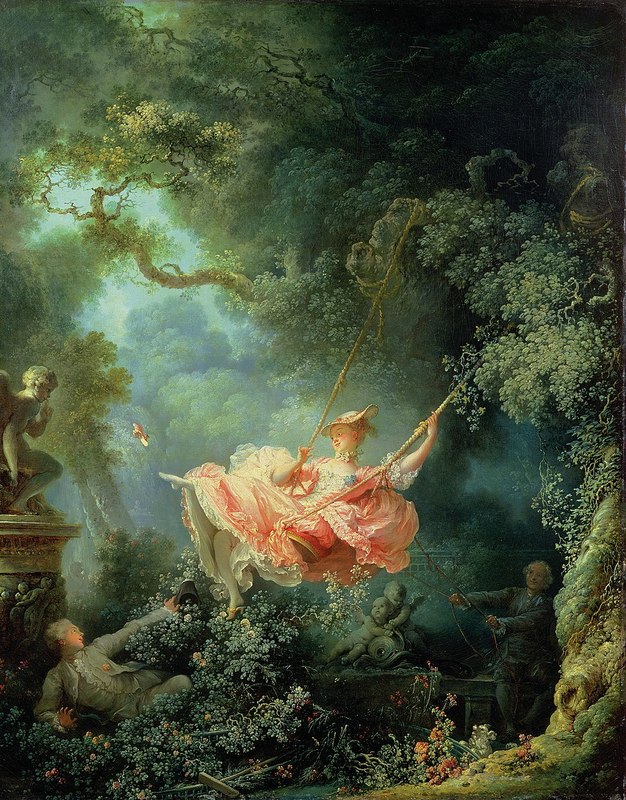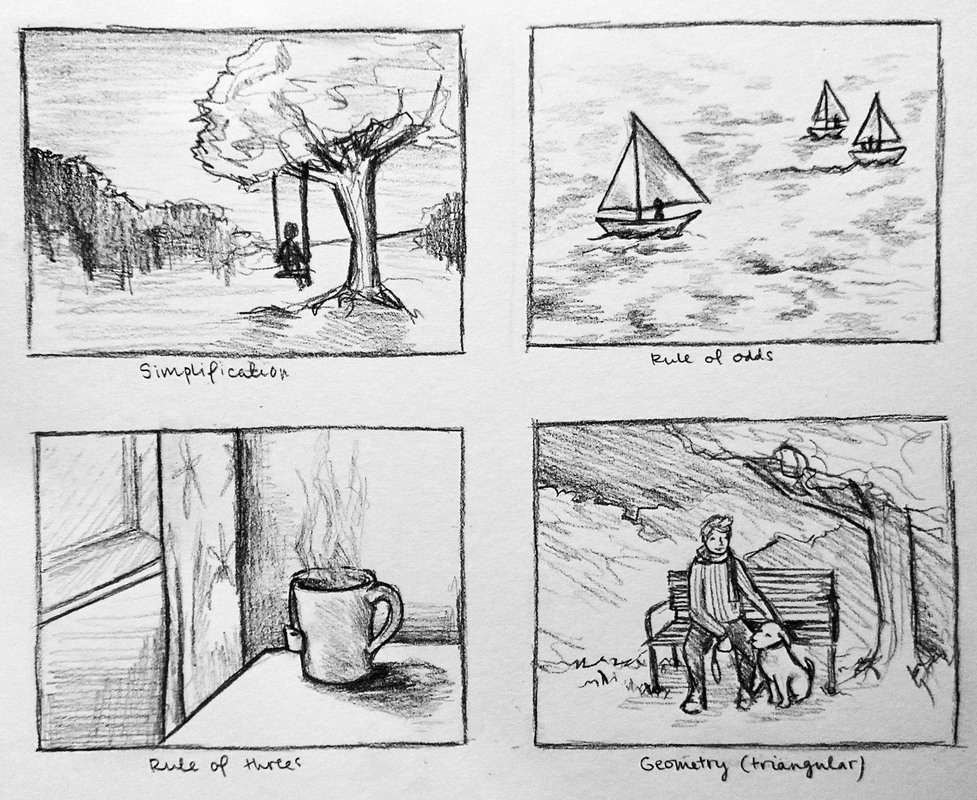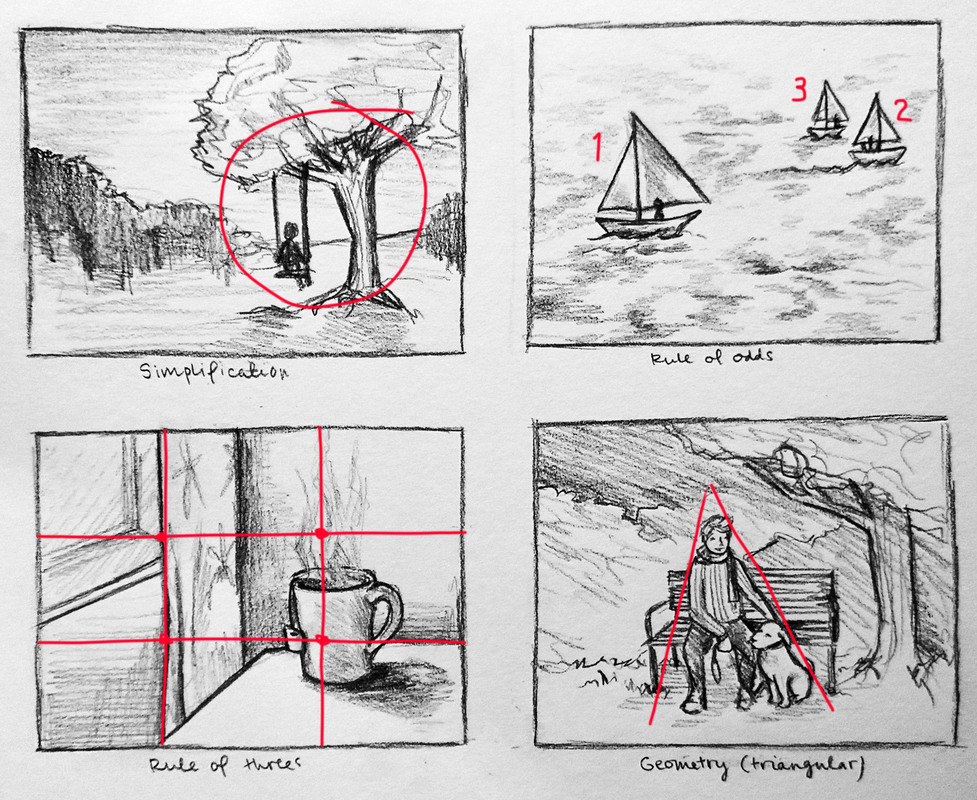Composition
In any type of art, composition is very important. Composition means the way different elements are arranged in a work of art, whether two- or three-dimensional. Composition creates rhythm, balance and movement in art. It can be very important in creating the atmosphere or "feeling" of the artwork.
While creating a composition, you should think about where you want the focal point to be. A focal point is the part in a work of art that the viewer focuses on. To create a strong focal point, you might use a different colour, a surprising element or a dynamic composition.

 On the left in Fragonard's The Swing (1767), the focal point is created by using colour contrast. Most of the painting is green, but the woman on the swing is completely painted using different hues of red, pink and white. The viewer instantly looks at the woman, and might miss the other two characters entirely - did you see them?
On the left in Fragonard's The Swing (1767), the focal point is created by using colour contrast. Most of the painting is green, but the woman on the swing is completely painted using different hues of red, pink and white. The viewer instantly looks at the woman, and might miss the other two characters entirely - did you see them?
On the right is Hugo Simberg's Spring Feeling (1895). This painting has two focal points: one might look at the man and two kids at first, but focus is quickly shifted to the back, where two women seem to be having some trouble with the cow. Here, the focal points are created by adding interesting elements, such as the woman pulling the cow from its tail.
Some types of compositions have been used very often, and are typical of a certain era of art. Classical art often used triangular or pyramidic compositions to create balance. Modern art tried to shake things up by leaving the traditional composition behind, but even then, the paintings stayed within the canvas. Some contemporary artists have taken composition even further by having it leave the work of art altogether. Da Vinci's The Virgin and Child with Saint Anne (1503, below) follows the traditional triangular composition. The figures form a triangle, Saint Anne's head being the top point of the shape.

Some ways to create interesting compositions include:
Simplification: Use limited colours, remove everything extra. Add more detail or colour to the focus point(s). This helps emphasise certain details.
Rule of odds: An odd number of subjects is often more interesting than an even number! So instead of 2 or 4 subjects, try 3 (3 is also considered a pleasing number of subjects)
The golden ratio (or as a simplified version, the rule of threes): To create an interesting composition, divide your canvas into three parts both vertically and horizontally to create nine squares. Place the subjects or objects of interest into one one of the intersections (where a horizontal and a vertical line meet!). Make sure each section is different!
Geometry: Triangles and triangle-shaped things are often pleasing to the eye!


Think 1.3 Where could you use each of these compositional arrangements? Where might they be best suited? Think about a few examples of where to use these different types of compositions.
Test 1.3 Test out different compositions. Draw or use cutouts from magazines; choose 3-8 different elements. Try out arranging these elements on a paper or on the table (a paper is easier, because you can see where the canvas ends). Try moving the elements around; how does this change the feeling of the composition? Take pictures of different arrangements and add them in your portfolio. Describe each arrangement in a few words: what does it feel like, what is the focus point?
While creating a composition, you should think about where you want the focal point to be. A focal point is the part in a work of art that the viewer focuses on. To create a strong focal point, you might use a different colour, a surprising element or a dynamic composition.

 On the left in Fragonard's The Swing (1767), the focal point is created by using colour contrast. Most of the painting is green, but the woman on the swing is completely painted using different hues of red, pink and white. The viewer instantly looks at the woman, and might miss the other two characters entirely - did you see them?
On the left in Fragonard's The Swing (1767), the focal point is created by using colour contrast. Most of the painting is green, but the woman on the swing is completely painted using different hues of red, pink and white. The viewer instantly looks at the woman, and might miss the other two characters entirely - did you see them?On the right is Hugo Simberg's Spring Feeling (1895). This painting has two focal points: one might look at the man and two kids at first, but focus is quickly shifted to the back, where two women seem to be having some trouble with the cow. Here, the focal points are created by adding interesting elements, such as the woman pulling the cow from its tail.
Some types of compositions have been used very often, and are typical of a certain era of art. Classical art often used triangular or pyramidic compositions to create balance. Modern art tried to shake things up by leaving the traditional composition behind, but even then, the paintings stayed within the canvas. Some contemporary artists have taken composition even further by having it leave the work of art altogether. Da Vinci's The Virgin and Child with Saint Anne (1503, below) follows the traditional triangular composition. The figures form a triangle, Saint Anne's head being the top point of the shape.

Some ways to create interesting compositions include:
Simplification: Use limited colours, remove everything extra. Add more detail or colour to the focus point(s). This helps emphasise certain details.
Rule of odds: An odd number of subjects is often more interesting than an even number! So instead of 2 or 4 subjects, try 3 (3 is also considered a pleasing number of subjects)
The golden ratio (or as a simplified version, the rule of threes): To create an interesting composition, divide your canvas into three parts both vertically and horizontally to create nine squares. Place the subjects or objects of interest into one one of the intersections (where a horizontal and a vertical line meet!). Make sure each section is different!
Geometry: Triangles and triangle-shaped things are often pleasing to the eye!


Think 1.3 Where could you use each of these compositional arrangements? Where might they be best suited? Think about a few examples of where to use these different types of compositions.
Test 1.3 Test out different compositions. Draw or use cutouts from magazines; choose 3-8 different elements. Try out arranging these elements on a paper or on the table (a paper is easier, because you can see where the canvas ends). Try moving the elements around; how does this change the feeling of the composition? Take pictures of different arrangements and add them in your portfolio. Describe each arrangement in a few words: what does it feel like, what is the focus point?